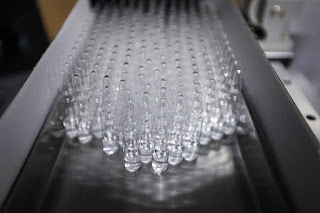On the fifth of March, my parents got their first shot of Oxford/AstraZeneca vaccine (called Covishield in India). They were told to get the second shot four weeks later. Today, the Indian government asked the states to increase the gap between doses to 6-8 weeks. Reportedly, the Oxford vaccine will henceforth be given only as a second dose. Anyone coming for the first dose will be given Covaxin, a locally developed vaccine by Bharat Biotech.
The Serum Institute of India, the world’s largest
vaccine producer, has informed several countries of possible delays in supply. The
European Union, embarrassingly lagging in vaccination, is considering banning
export of vaccines. UK’s ambitious plans have suddenly hit a roadblock.
Why are the vaccine shipments getting delayed everywhere?
*****
Anyone who has worked in the manufacturing industry
knows how complicated supply chains can be. The i-phone, the size of our palm,
is assembled in China with components coming from over 27 countries. Each
product has suppliers for equipment and raw materials, and the suppliers in
turn have other suppliers. The logistics of this entire pyramid must work as
planned. Even in our personal lives, we know the wide variance between our plans,
our desires, and reality.
Industries get close to their targets after decades of
trial. But covid vaccine production is an infant. A year ago, the USA invested billions of
dollars to develop the vaccines, but not enough attention was paid to the
supply of the raw materials.
The raw material suppliers had full sets of orders
from pharma companies for items totally unrelated to covid. Now suddenly, they
have been asked to set everything aside, expand their capacities, build new
equipment, employ skilled workers, and refuse supplying to their earlier
customers.
*****
A new production facility for a vaccine like Oxford
can take six to nine months. The biggest issue, unrelated to raw materials, is
with yields. Yields depend on the health of the underlying cell culture.
Quality control issues, such as those relating to temperature, humidity or
compromised sterility, lead to less vaccine at the end of the process.
Surprisingly, at two identical facilities, the yields can vary by a as much as
an order of three. Human nature, particularly in an emergency, tends to take
the best-case scenario. Even running three shifts doesn’t help when the output
can vary wildly.
*****
A shortage of any critical item results in irreplaceable
shortage of vaccines. Pfizer, Moderna and Novavax vaccines use bioreactor tanks.
If it was a restaurant kitchen, you could call them containers for vaccine
soup. The bioreactor tanks need giant disposable plastic bags as sterile
liners. Without them the vaccine may get contaminated. In EU and some other
countries, this has emerged as a production bottleneck. The sterile plastic
bags are produced by a small number of suppliers, and vaccine producers have struggled
to source them. Merck has now announced expansion plans to address this issue.
*****
Or take the case of vials. The liquid vaccine
has to be put into vials before it can be distributed. Pfizer and Moderna vaccines
require ultra-cold temperatures to preserve them. Normal glass vials would break
in the super-freezers. Just a single damaged vial can ruin an entire batch of
doses and stop the production line. Corning, the US manufacturer, was asked to
supply special super strong Pharma grade glass called Valor.
Most vials need rubber stoppers. In autumn
2020, tropical storms in Thailand, Vietnam and India led to rubber shortages.
United States of America is now hoarding rubber. Both
Trump and Biden used a 1950 act from the Korean war times called “the defence
production act”. This allows US presidents to order a private company to divert
manufacturing to what the State needs. A year ago, for example, General motors
was ordered to produce ventilators. Biden is likely to use this act to use the scarce
rubber for vaccine needs.
Rubber gloves are recommended to administer a vaccine. Except the
USA, all other nations are likely to face shortages of rubber.
*****
More on the bottlenecks tomorrow.
Ravi

Again filling in the gaps in my understanding of the News
ReplyDeleteअमेरिका हावरट आहे
ReplyDelete